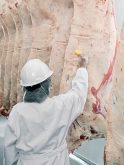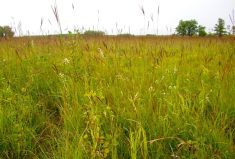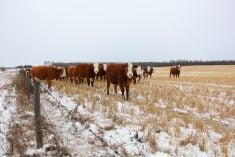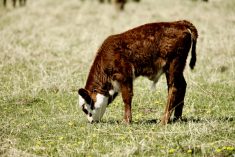My first fire drill in Grade 1 was absolute chaos, screaming and panic as we all circled the teacher, who was likely wondering how our parents had managed to keep us alive this long. By Grade 3, we yawned and strolled to the nearest door. Fire drills teach kids what to do when there’s no real threat, so that they react calmly and automatically if a real fire happens. Fire drills save lives. Vaccines are for disease what fire drills are for kids.
When an animal is exposed to a disease-causing microbe, the immune system activates a variety of self-defence weapons to combat it. The immune system often responds a bit slowly the first time the microbe is encountered, because it’s starting from scratch. But the immune system has a “memory” that allows it to respond much more quickly and automatically the next time that microbe reappears.
Read Also

Body condition, nutrition and vaccination for brood cows
One of the remarkable events of the past century related to ranching has been the genetic evolution of brood cows….
Like a fire drill, a vaccine mimics exposure to disease-causing microbes without causing the disease. Nearly all vaccines recommend two doses, given a few weeks apart. The initial vaccination is like the fire drill in Grade 1. It teaches the animal’s immune system to recognize particular features of a microbe that causes a specific disease. The second “booster” dose given a few weeks later is like the fire drill in Grade 3. It stimulates the immune system’s memory and generates a much stronger and long-lasting immune response and enables the immune system to spring into action if the microbe itself appears.
Reproductive diseases also require an annual booster for the breeding herd. Proper vaccination allows the animal’s immune system to respond much more quickly, automatically and effectively when a real disease challenge occurs.
Vaccines are getting better. Modified live vaccines provide longer-lasting protection than killed vaccines.“Multivalent” vaccines allow protection against multiple diseases at the same time. Nasal and oral vaccines allow calves to be vaccinated earlier in life, without needles.
Vaccines are an important part of a preventative herd health program, but they aren’t a silver bullet. They won’t eliminate disease, but they do reduce the risk, and are much more affordable than trying to gain the upper hand on an uncontrolled disease outbreak. Vaccines need to be handled and administered properly and work best when combined with other best management practices in areas such as nutrition, animal handling and biosecurity.
Dr. Cheryl Waldner and coworkers from the Western College of Veterinary Medicine recently published a study on Vaccine usage in western Canadian cow-calf herds (Canadian Veterinary Journal 60:414-442).
What they did: The team surveyed producers participating in the Western Canadian Cow-Calf Surveillance Network in early 2017. Participants were given a handbook that included color pictures and product names of vaccines approved for use in Canada and were asked to identify which vaccines they’d used (and when) for cows, heifers, bulls and calves in the 2016 calendar year.
What they learned: The vast majority of producers vaccinated both cows (91 per cent) and replacement heifers (96 per cent) against BVD and IBR, which can cause reproductive failure; fewer vaccinated bulls for these diseases (55 per cent). Most of these would have been annual booster vaccinations.
Nearly all producers vaccinated calves against clostridial diseases (97 per cent). Most producers vaccinated calves against BVD (82 per cent) and IBR (85 per cent) at least once; many of these vaccines also provide protection against the PI3 and BRSV respiratory viruses. But only about a third of operations provided a second (or booster) vaccination against any of these diseases. That means that the vaccines are likely only providing partial protection against respiratory disease.
What it means: Vaccination rates are going up in Western Canadian cow-calf operations. Earlier studies reported vaccination rates below 50 per cent for reproductive diseases in cows and heifers, below 90 per cent for clostridial diseases, and below 50 per cent for respiratory diseases in calves.
Vaccines that protect against diseases that cause abortion or infertility in cows (like BVD and IBR) or easily preventable diseases (e.g. clostridial diseases) are understandably top-of-mind for most cow-calf producers. So, it’s not particularly surprising that vaccination rates are high and annual boosters are common in the cow herd.
It’s also encouraging to see the increase in vaccination rates against respiratory viruses in calves. Bovine respiratory disease is often considered a “feedlot disease,” but it’s also a leading reason for antibiotic use on Canadian cow-calf operations. A 2013 study (Antimicrobial usage in western Canadian cow-calf herds; Canadian Veterinary Journal 60:255–267) found that up to 77 per cent of Canadian cow-calf operations used antibiotics to treat up to a third of their calves for respiratory disease either before or after weaning. All those individual treatments still add up to significant time, effort and expense. Providing calves with the recommended booster against respiratory viruses like BVD, IBR, PI3 and BRSV will help reduce the need for antibiotic treatments before the calves leave the farm.
Now would be a really good time to provide that booster vaccination. Spending a few hours on a “fire drill” now will save time and money treating individual calves in the fall when you have other things to do. Fire drills save lives.
The Beef Cattle Research Council is funded by the Canadian Beef Cattle Check-Off. The BCRC partners with Agriculture and Agri-Food Canada, provincial beef industry groups and governments to advance research and technology transfer supporting the Canadian beef industry’s vision to be recognized as a preferred supplier of healthy, high-quality beef, cattle and genetics.

















